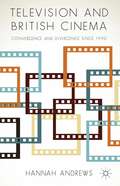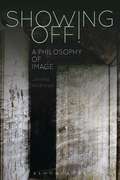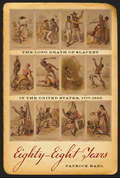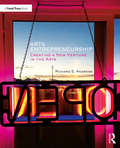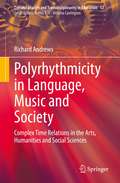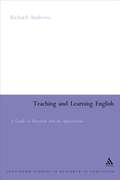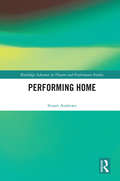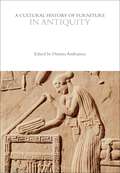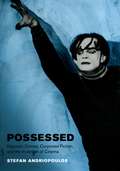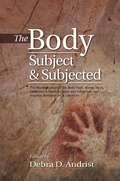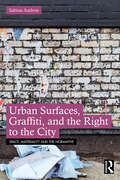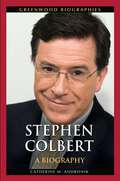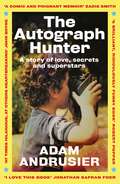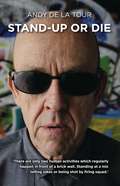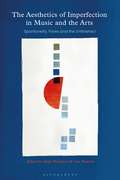- Table View
- List View
Television and British Cinema: Convergence and Divergence Since 1990
by Hannah AndrewsUndertaking a thorough and timely investigation of the relationship between television and cinema in Britain since 1990, Hannah Andrews explores the convergence between the two forms, at industrial, cultural and intermedial levels, and the ways in which the media have also been distinguished from one another through discourse and presentation.
Showing Off!: A Philosophy of Image
by Jorella AndrewsDrawing on art, media, and phenomenological sources, Showing Off!: A Philosophy of Image challenges much recent thought by proposing a fundamentally positive relationship between visuality and the ethical. In philosophy, cultural studies and art, relationships between visuality and the ethical are usually theorized in negative terms, according to the dyadic logics of seeing on the one hand, and being seen, on the other. Here, agency and power are assumed to operate either on the side of those who see, or on the side of those who control the means by which people and things enter into visibility. To be seen, by contrast - when it occurs outside of those parameters of control- is to be at a disadvantage; hence, for instance, contemporary theorist Peggy Phelan's rejection of the idea, central to activist practices of the 1970's and 80's, that projects of political emancipation must be intertwined with, and are dependent on, processes of 'making oneself visible'. Acknowledgment of the vulnerability of visibility also underlies the realities of life lived within increasingly pervasive systems of imposed and self-imposed surveillance, and apparently confident public performances of visual self display.Showing Off!: A Philosophy of Image is written against the backdrop of these phenomena, positions and concerns, but asks what happens to our debates about visibility when a third term, that of 'self-showing', is brought into play. Indeed, it proposes a fundamentally positive relationship between visuality and the ethical, one primarily rooted not in acts of open and non-oppressive seeing or spectating, as might be expected, but rather in our capacity to inhabit both the risks and the possibilities of our own visible being. In other words, this book maintains that the proper site of generosity and agency within any visual encounter is located not on the side of sight, but on that of self-showing - or showing off!
Showing Off!: A Philosophy of Image (Bloomsbury Revelations Ser.)
by Jorella AndrewsDrawing on art, media, and phenomenological sources, Showing Off!: A Philosophy of Image challenges much recent thought by proposing a fundamentally positive relationship between visuality and the ethical. In philosophy, cultural studies and art, relationships between visuality and the ethical are usually theorized in negative terms, according to the dyadic logics of seeing on the one hand, and being seen, on the other. Here, agency and power are assumed to operate either on the side of those who see, or on the side of those who control the means by which people and things enter into visibility. To be seen, by contrast - when it occurs outside of those parameters of control- is to be at a disadvantage; hence, for instance, contemporary theorist Peggy Phelan's rejection of the idea, central to activist practices of the 1970's and 80's, that projects of political emancipation must be intertwined with, and are dependent on, processes of 'making oneself visible'. Acknowledgment of the vulnerability of visibility also underlies the realities of life lived within increasingly pervasive systems of imposed and self-imposed surveillance, and apparently confident public performances of visual self display.Showing Off!: A Philosophy of Image is written against the backdrop of these phenomena, positions and concerns, but asks what happens to our debates about visibility when a third term, that of 'self-showing', is brought into play. Indeed, it proposes a fundamentally positive relationship between visuality and the ethical, one primarily rooted not in acts of open and non-oppressive seeing or spectating, as might be expected, but rather in our capacity to inhabit both the risks and the possibilities of our own visible being. In other words, this book maintains that the proper site of generosity and agency within any visual encounter is located not on the side of sight, but on that of self-showing - or showing off!
Langford's Starting Photography: The Guide to Creating Great Images
by Philip AndrewsStarting with the basics of camera control and moving on to shutter speeds, aperture, zoom and flash, Langford’s Starting Photography gives you the only introduction to digital photography you’ll ever need. Once you’ve mastered the basics, examples and projects allow you to explore the key methods for capturing a variety of subjects from portraits and pets to landscapes and sports photography, alongside straightforward advice on using editing software to get the best out of your digital shots, will have you producing unforgettable images in moments. More inspiring than a textbook, more interesting than a reference, and more in-depth than a photography class, Langford’s Starting Photography is the only guide you need to start taking great images.
Langford's Starting Photography: The Guide to Creating Great Images
by Philip AndrewsStarting with the basics of camera control and moving on to shutter speeds, aperture, zoom and flash, Langford’s Starting Photography gives you the only introduction to digital photography you’ll ever need. Once you’ve mastered the basics, examples and projects allow you to explore the key methods for capturing a variety of subjects from portraits and pets to landscapes and sports photography, alongside straightforward advice on using editing software to get the best out of your digital shots, will have you producing unforgettable images in moments. More inspiring than a textbook, more interesting than a reference, and more in-depth than a photography class, Langford’s Starting Photography is the only guide you need to start taking great images.
Arts Entrepreneurship: Creating a New Venture in the Arts
by Richard AndrewsArts Entrepreneurship: Creating a New Venture in the Arts provides the essential tools, techniques, and concepts needed to invent, launch, and sustain a business in the creative sector. Building on the reader’s artistic talents and interests, the book provides a practical, action-oriented introduction to the business of art, focusing on product design, organizational planning and assessment, customer identification and marketing, fundraising, legal issues, money management, cultural policy, and career development. It also offers examples, exercises, and references that guide entrepreneurs through the key stages of concept creation, business development, and growth. Special attention is paid to topics such as cultural ventures seeking social impact, the emergence of creative placemaking, the opportunities afforded by novel corporate forms, and the role of contemporary technologies in marketing, fundraising, and operations. A hands-on guide to entrepreneurial success, this book is a valuable resource for students of Arts Entrepreneurship programs, courses, and workshops, as well as for early-stage business founders in the creative sector looking for guidance on how to create and sustain their own successful venture.
Arts Entrepreneurship: Creating a New Venture in the Arts
by Richard AndrewsArts Entrepreneurship: Creating a New Venture in the Arts provides the essential tools, techniques, and concepts needed to invent, launch, and sustain a business in the creative sector. Building on the reader’s artistic talents and interests, the book provides a practical, action-oriented introduction to the business of art, focusing on product design, organizational planning and assessment, customer identification and marketing, fundraising, legal issues, money management, cultural policy, and career development. It also offers examples, exercises, and references that guide entrepreneurs through the key stages of concept creation, business development, and growth. Special attention is paid to topics such as cultural ventures seeking social impact, the emergence of creative placemaking, the opportunities afforded by novel corporate forms, and the role of contemporary technologies in marketing, fundraising, and operations. A hands-on guide to entrepreneurial success, this book is a valuable resource for students of Arts Entrepreneurship programs, courses, and workshops, as well as for early-stage business founders in the creative sector looking for guidance on how to create and sustain their own successful venture.
Polyrhythmicity in Language, Music and Society: Complex Time Relations in the Arts, Humanities and Social Sciences (Cultural Studies and Transdisciplinarity in Education #12)
by Richard AndrewsThis book addresses the complex time relations that occur in some types of jazz and classical music, as well as in the novel, plays and poetry. It discusses these multiple levels of rhythm from a social science as well as an arts and humanities perspective. Building on his ground-breaking work in Re-framing Literacy, A Prosody of Free Verse and Multimodality, Poetry and Poetics, the author explores the world of multiple- or poly-rhythms in music, literature and the social sciences. He reveals that multi-layered rhythms are uncommon and little researched. Nevertheless, they are important to the experience of art and social situations, not least because they link physicality to feeling and to decision-making (timing), as well as to aesthetic experience. Whereas most poly-rhythmic relations are felt unconsciously, this book reveals the complex patterning that underpins the structures of feeling and of experience.
Teaching and Learning English: A Guide to Recent Research and its Applications
by Richard AndrewsThere is increasingly wide agreement amongst teachers, researchers, inspectors, advisers and policy-makers that both teaching and research will benefit from the two activities being brought closer together. But how can this be achieved? Hard-pressed practitioners can hardly be expected constantly to review a constant flow of conference papers, journals and other publications, even if such items were accessible and clearly understood. This unique book synthesizes relevant research findings for the professional practioner and highlights their implications for the quality of teaching and learning. Whether you are a teacher looking to improve your practice through applying the latest thinking in your subject or a researcher searching for a concise review of the literature, this book will be a vital acquisition.
Performing Home (Routledge Advances in Theatre & Performance Studies)
by Stuart AndrewsPerforming Home is the first sustained study of the ways in which artists create artworks in, and in response to, domestic dwellings. In the context of growing interest in ideas and practices that cross between architecture, arts practice and performance, it is valuable to understand what happens when artists make work in and about specific buildings. This is particularly important with domestic dwellings, which can be bound up with experiences, issues, practices and understandings of home. The book focuses on a range of recent artistic projects to identify and investigate critical ways by which artists practise domestic dwellings. In doing so, it addresses the ways in which artists enquire into a dwelling, are resident in a dwelling, adapt the form of a dwelling, practise a mobile dwelling, and make a dwelling. By considering these practices together, Andrews demonstrates the breadth and significance of recent artistic engagement in and with domestic dwellings and highlights the contribution that artistic practice can make to the ways in which we understand the form and practice of a building. Performing Home will be of particular relevance to scholars, students and practitioners in architecture, art and performance, to those in geography, material culture and cultural studies, and to anyone seeking to make sense of the place in which they live.
Performing Home (Routledge Advances in Theatre & Performance Studies)
by Stuart AndrewsPerforming Home is the first sustained study of the ways in which artists create artworks in, and in response to, domestic dwellings. In the context of growing interest in ideas and practices that cross between architecture, arts practice and performance, it is valuable to understand what happens when artists make work in and about specific buildings. This is particularly important with domestic dwellings, which can be bound up with experiences, issues, practices and understandings of home. The book focuses on a range of recent artistic projects to identify and investigate critical ways by which artists practise domestic dwellings. In doing so, it addresses the ways in which artists enquire into a dwelling, are resident in a dwelling, adapt the form of a dwelling, practise a mobile dwelling, and make a dwelling. By considering these practices together, Andrews demonstrates the breadth and significance of recent artistic engagement in and with domestic dwellings and highlights the contribution that artistic practice can make to the ways in which we understand the form and practice of a building. Performing Home will be of particular relevance to scholars, students and practitioners in architecture, art and performance, to those in geography, material culture and cultural studies, and to anyone seeking to make sense of the place in which they live.
The Dramaturgy of the Door
by Stuart Andrews Matthew WagnerThe Dramaturgy of the Door examines the door as a critical but under-explored feature of theatre and performance, asking how doors function on stage, in site-specific practice and in performances of place. This first book-length study on the topic argues that doors engage in and help to shape broad phenomena of performance across key areas of critical enquiry in the field. Doors open up questions of theatrical space(s) and artistic encounters with place(s), design and architecture, bodies and movement, interior versus exterior, im/materiality, the relationship between the real and the imaginary, and processes of transformation. As doors separate places and practices, they also invite us to see connections and contradictions between each one and to consider the ways in which doors frame the world beyond the stage and between places of performance. With a wide-ranging set of examples – from Shakespeare’s Macbeth to performance installations in the Mojave Desert – The Dramaturgy of the Door is aimed at performance makers and artists as well as advanced students and scholars in the fields of performance studies, cultural theory, and visual arts.
The Dramaturgy of the Door
by Stuart Andrews Matthew WagnerThe Dramaturgy of the Door examines the door as a critical but under-explored feature of theatre and performance, asking how doors function on stage, in site-specific practice and in performances of place. This first book-length study on the topic argues that doors engage in and help to shape broad phenomena of performance across key areas of critical enquiry in the field. Doors open up questions of theatrical space(s) and artistic encounters with place(s), design and architecture, bodies and movement, interior versus exterior, im/materiality, the relationship between the real and the imaginary, and processes of transformation. As doors separate places and practices, they also invite us to see connections and contradictions between each one and to consider the ways in which doors frame the world beyond the stage and between places of performance. With a wide-ranging set of examples – from Shakespeare’s Macbeth to performance installations in the Mojave Desert – The Dramaturgy of the Door is aimed at performance makers and artists as well as advanced students and scholars in the fields of performance studies, cultural theory, and visual arts.
A Cultural History of Furniture in Antiquity (The Cultural Histories Series)
by Dimitra AndrianouCovering the period from 2500 BCE to the Byzantine Era, this volume focuses on the social history of furniture found in houses, tombs and temples as narrated through the archaeological evidence. The earliest furniture can be seen as an attempt by humans to enhance their safety, comfort and social standing but it can also offer opportunities for understanding human behavior, values and thought: fine furniture was among the most valuable of possessions in the ancient world so it expressed power, wealth and status. It was appreciated as art, used in diplomacy (both as a gift and as tribute) and recorded as booty. At the same time, its practical and ceremonial uses yield important clues about the domestic environment and daily life in antiquity, as well as revealing aspects of sacred belief and funerary practices.Drawing upon a wealth of visual and textual sources, this volume presents essays that examine key characteristics of the furniture of the period on the themes of Design and Motifs; Makers, Making, and Materials; Types and Uses; The Domestic Setting; The Public Setting; Exhibition and Display; Furniture and Architecture; Visual Representations; and Verbal Representations.
Possessed: Hypnotic Crimes, Corporate Fiction, and the Invention of Cinema (Cinema and Modernity)
by Stefan AndriopoulosSilent cinema and contemporaneous literature explored themes of mesmerism, possession, and the ominous agency of corporate bodies that subsumed individual identities. At the same time, critics accused film itself of exerting a hypnotic influence over spellbound audiences. Stefan Andriopoulos shows that all this anxiety over being governed by an outside force was no marginal oddity, but rather a pervasive concern in the late nineteenth and early twentieth centuries. Tracing this preoccupation through the period’s films—as well as its legal, medical, and literary texts—Andriopoulos pays particular attention to the terrifying notion of murder committed against one’s will. He returns us to a time when medical researchers described the hypnotized subject as a medium who could be compelled to carry out violent crimes, and when films like The Cabinet of Dr. Caligari and Dr. Mabuse, the Gambler famously portrayed the hypnotist’s seemingly unlimited power on the movie screen. Juxtaposing these medicolegal and cinematic scenarios with modernist fiction, Andriopoulos also develops an innovative reading of Kafka’s novels, which center on the merging of human and corporate bodies. Blending theoretical sophistication with scrupulous archival research and insightful film analysis, Possessed adds a new dimension to our understanding of today’s anxieties about the onslaught of visual media and the expanding reach of vast corporations that seem to absorb our own identities.
Possessed: Hypnotic Crimes, Corporate Fiction, and the Invention of Cinema (Cinema and Modernity)
by Stefan AndriopoulosSilent cinema and contemporaneous literature explored themes of mesmerism, possession, and the ominous agency of corporate bodies that subsumed individual identities. At the same time, critics accused film itself of exerting a hypnotic influence over spellbound audiences. Stefan Andriopoulos shows that all this anxiety over being governed by an outside force was no marginal oddity, but rather a pervasive concern in the late nineteenth and early twentieth centuries. Tracing this preoccupation through the period’s films—as well as its legal, medical, and literary texts—Andriopoulos pays particular attention to the terrifying notion of murder committed against one’s will. He returns us to a time when medical researchers described the hypnotized subject as a medium who could be compelled to carry out violent crimes, and when films like The Cabinet of Dr. Caligari and Dr. Mabuse, the Gambler famously portrayed the hypnotist’s seemingly unlimited power on the movie screen. Juxtaposing these medicolegal and cinematic scenarios with modernist fiction, Andriopoulos also develops an innovative reading of Kafka’s novels, which center on the merging of human and corporate bodies. Blending theoretical sophistication with scrupulous archival research and insightful film analysis, Possessed adds a new dimension to our understanding of today’s anxieties about the onslaught of visual media and the expanding reach of vast corporations that seem to absorb our own identities.
Body, Subject & Subjected: The Representation of the Body Itself, Illness, Injury, Treatment and Death in Spain and Indigenous and Hispanic American Art and Literature
by Debra D. AndristHominids have always been obsessed with representing their own bodies. The first "selfies" were prehistoric negative hand images and human stick figures, followed by stone and ceramic representations of the human figure. Thousands of years later, moving via historic art and literature to contemporary social media, the contemporary term "selfie" was self-generated. The book illuminates some "selfies". This collection of critical essays about the fixation on the human self addresses a multi-faceted geographic set of cultures -- the Iberian Peninsula to pre-Columbian America and Hispanic America -- analysing such representations from medical, literal and metaphorical perspectives over centuries. Chapter contributions address the representation of the body itself as subject, in both visual and textual manners, and illuminate attempts at control of the environment, of perception, of behaviour and of actions, by artists and authors. Other chapters address the body as subjected to circumstance, representing the body as affected by factors such as illness, injury, treatment and death. These myriad effects on the body are interpreted through the brushes of painters and the pens of authors for social and/or personal control purposes. The essays reveal critics' insights when "selfies" are examined through a focused "lens" over a breadth of cultures. The result, complex and unique, is that what is viewed -- the visual art and literature under discussion -- becomes a mirror image, indistinguishable from the component viewing apparatus, the "lens".
Urban Surfaces, Graffiti, and the Right to the City (ISSN)
by Sabina AndronThis landmark book focuses on urban surfaces, on exploring their authorship and management, and on their role in struggles for the right to the city.Graffiti, pristine walls, advertising posters, and municipal signage all compete on city surfaces to establish and imprint their values on our environments. It is the first time that the surfacescapes of our cities are granted the entire attention of a book as material, visual, and legal territories. The book includes a critical history of graffiti and street art as contested surface discourses and argues for surfaces as sites of resistance against private property, neoliberal creativity, and the imposition of urban order. It also proposes a seven-point manual for a semiotics of urban surfaces, laying the ground for a new discipline: surface studies.Page after page and layer after layer, surfaces become porous and political and emerge as key spatial conditions for rethinking and re-practicing urban dwelling and spatial justice. They become what the author terms the surface commons.The book will appeal to a wide readership across the disciplines of urban studies, architectural theory and design, graffiti, street art and public art, criminology, semiotics, visual culture, and urban and legal geography. It will also serve as a tool for city scholars, policy makers, artists, and vandals to disrupt existing imaginaries of order, justice, and visibility in cities.
Urban Surfaces, Graffiti, and the Right to the City (ISSN)
by Sabina AndronThis landmark book focuses on urban surfaces, on exploring their authorship and management, and on their role in struggles for the right to the city.Graffiti, pristine walls, advertising posters, and municipal signage all compete on city surfaces to establish and imprint their values on our environments. It is the first time that the surfacescapes of our cities are granted the entire attention of a book as material, visual, and legal territories. The book includes a critical history of graffiti and street art as contested surface discourses and argues for surfaces as sites of resistance against private property, neoliberal creativity, and the imposition of urban order. It also proposes a seven-point manual for a semiotics of urban surfaces, laying the ground for a new discipline: surface studies.Page after page and layer after layer, surfaces become porous and political and emerge as key spatial conditions for rethinking and re-practicing urban dwelling and spatial justice. They become what the author terms the surface commons.The book will appeal to a wide readership across the disciplines of urban studies, architectural theory and design, graffiti, street art and public art, criminology, semiotics, visual culture, and urban and legal geography. It will also serve as a tool for city scholars, policy makers, artists, and vandals to disrupt existing imaginaries of order, justice, and visibility in cities.
Stephen Colbert: A Biography (Greenwood Biographies)
by Catherine M. AndronikThis book explores how comedian Stephen Colbert's satiric views of American life have captured the imagination of viewers around the world—and sharpened these individuals' own critical interpretations and opinions on current events.Stephen Colbert may be "just a comedian"—one not all audiences find funny, especially among those who have been mercilessly lampooned by him—but there is no arguing that the condescending, bombastic, and largely ignorant pundit he plays on Comedy Central has brought awareness of current events and political happenings to a substantially larger portion of the American population.The only available biography on Stephen Colbert, this book examines his life story and details how he became one of the most influential people on current American culture. Beginning with coverage of Colbert's childhood, the chapters discuss his education, highlighting his interest in drama; describe his introduction to the world of comedy; review his contributions as a "correspondent" on The Daily Show with Jon Stewart; and focus on Colbert's accomplishments and antics as the star of his faux news program that debuted in the fall of 2005, The Colbert Report.
Stephen Colbert: A Biography (Greenwood Biographies)
by Catherine M. AndronikThis book explores how comedian Stephen Colbert's satiric views of American life have captured the imagination of viewers around the world—and sharpened these individuals' own critical interpretations and opinions on current events.Stephen Colbert may be "just a comedian"—one not all audiences find funny, especially among those who have been mercilessly lampooned by him—but there is no arguing that the condescending, bombastic, and largely ignorant pundit he plays on Comedy Central has brought awareness of current events and political happenings to a substantially larger portion of the American population.The only available biography on Stephen Colbert, this book examines his life story and details how he became one of the most influential people on current American culture. Beginning with coverage of Colbert's childhood, the chapters discuss his education, highlighting his interest in drama; describe his introduction to the world of comedy; review his contributions as a "correspondent" on The Daily Show with Jon Stewart; and focus on Colbert's accomplishments and antics as the star of his faux news program that debuted in the fall of 2005, The Colbert Report.
Two Hitlers and a Marilyn: A comedy coming-of-age memoir about autographs, collecting and celebrity obsession
by Adam Andrusier'I love this book. It is wise, funny, surprising, touching, and wonderful company.' Jonathan Safran Foer'A comic and poignant memoir about growing up in the suburbs, fandom, stalking Ronnie Barker, and much more. A funny, moving read.' Zadie Smith'At times hilarious, at others heartbreaking, Andrusier's memoir provides a fascinating insight into obsession.' John Boyne'Hilarious and moving.' David Baddiel"I'd managed to puncture a hole between our universe and the parallel one where all the celebrities lived." Adam Andrusier spent his childhood in pursuit of autographs. After writing to every famous person he could think of, from Frank Sinatra to Colonel Gaddafi, he soon jostled with the paparazzi at stage doors and came face-to-face with the most famous people on the planet. For young Adam, autographs were a backstage pass to a world beyond his chaotic family home in Pinner, and his Holocaust-obsessed father. They provided a special connection to a world of glamour and significance lying just beyond his reach.But as Adam turned from collector to dealer, learning how to spot a fake from the real deal, he discovered that in life, as in autographs, not everything is as it first appears. When your obsession is a search for the authentic, what happens when you discover fraudulence in your own family?Two Hitlers and a Marilyn is a hilarious and moving account of discovering that idols are mortals. It's a story of growing up, forgiveness and discovering a place in the world.'The zaniest book I've read in eons. Andrusier is a fresh new voice and more importantly he's funny as hell.' Gary Shteyngart'Madcap and thoroughly engaging, Adam Andrusier's vivid memoir brings to mind the early Philip Roth. This is a book of antic comedy that resonates and intrigues.' Lisa Appignanesi'A fabulously interesting book and incredibly pleasurable to read. Very funny and strangely entrancing. It is about so much, but effortlessly.' Adam Phillips'Adam Andrusier has created that rare thing: a memoir which delivers the coming-of-age but also reaches far beyond. The writing here about family is excellent, the characters and scenes memorable, but from the first they're engaged also in a history. Two Hitlers and a Marilyn takes in the world as widely as possible, always searching for significance and connection.' David Vann'Beautifully written.' Maureen Lipman
Stand-Up or Die
by Andy de la TourOriginally part of the UK alternative comedy scene, Andy de la Tour spent many years on the circuit, performing with the likes of Rik Mayall, Ben Elton, Alexei Sayle and French and Saunders. After a 20‐year break from stand‐up he returned to New York City, the genre’s spiritual home, to start all over again in the back‐rooms and dive bars of the Big Apple.This is one man’s journey through New York’s underground comedy scene. From ‘Rubber Bullets’ in lower Manhattan to the ‘Hot Tub’ in Brooklyn, Andy takes the stand. Can he makethem laugh? Will New Yorkers stomach his outsider’s take on Obama, the Tea Party and 9/11? Andy’s a long way from home and dying is not an option.
The Aesthetics of Imperfection in Music and the Arts: Spontaneity, Flaws and the Unfinished
by Andy Hamilton and Lara PearsonThe aesthetics of imperfection emphasises spontaneity, disruption, process and energy over formal perfection and is often ignored by many commentators or seen only in improvisation. This comprehensive collection is the first time imperfection has been explored across all kinds of musical performance, whether improvisation or interpretation of compositions. Covering music, visual art, dance, comedy, architecture and design, it addresses the meaning, experience, and value of improvisation and spontaneous creation across different artistic media. A distinctive feature of the volume is that it brings together contributions from theoreticians and practitioners, presenting a wider range of perspectives on the issues involved. Contributors look at performance and practice across Western and non-Western musical, artistic and craft forms. Composers and non-performing artists offer a perspective on what is 'imperfect' or improvisatory within their work, contributing further dimensions to the discourse. The Aesthetics of Imperfection in Music and the Arts features 39 chapters organised into eight sections and written by a diverse group of scholars and performers. They consider divergent definitions of aesthetics, employing both 18th-century philosophy and more recent socially and historically situated conceptions making this an essential, up-to-date resource for anyone working on either side of the perfection-imperfection debate.
Teaching Science Fiction (Teaching the New English)
by Andy Sawyer and Peter WrightTeaching Science Fiction is the first text in thirty years to explore the pedagogic potential of that most intellectually stimulating and provocative form of popular literature: science fiction. Innovative and academically lively, it offers valuable insights into how SF can be taught historically, culturally and practically at university level.
